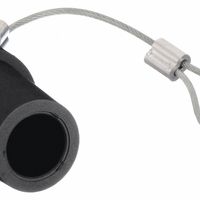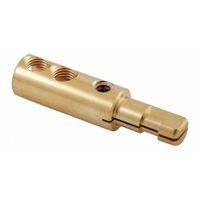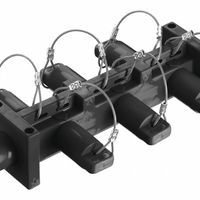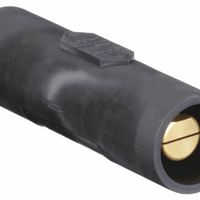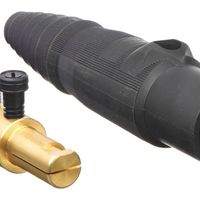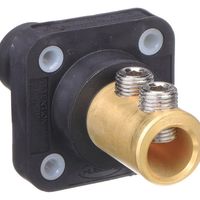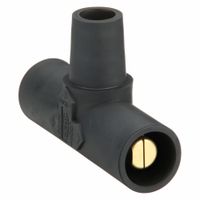Call +(254) 703 030 000 / 751 483 999 / 721 704 777
- Home
- Electrical
- Electrical Connectors Wiring Devices
- Plugs Receptacles Wiring Devices
- High Current Single Pole Plugs Receptacles
.....Read More
Frequently Asked Questions
What are high-current single-pole plugs and receptacles used for?
High-current single-pole plugs and receptacles are used for applications requiring the transmission of large amounts of electrical power. These devices are designed to handle high amperage, typically ranging from 100 to 400 amps or more, and are commonly used in environments where robust and reliable power connections are essential.
Key applications include:
1. **Entertainment and Events**: They are widely used in the entertainment industry for powering stage lighting, sound systems, and other equipment at concerts, theaters, and outdoor events. Their ability to handle high currents makes them ideal for temporary setups where quick and secure connections are necessary.
2. **Industrial Settings**: In industrial environments, these plugs and receptacles are used to power heavy machinery, welding equipment, and other high-power devices. Their durability and high current capacity make them suitable for harsh conditions and demanding applications.
3. **Construction Sites**: On construction sites, they provide power for large tools and equipment, such as cranes and concrete mixers. Their rugged design ensures they can withstand the rough handling and environmental challenges typical of construction environments.
4. **Temporary Power Distribution**: They are used in temporary power distribution systems, such as those needed for emergency power during outages or for temporary installations at fairs and festivals. Their ease of connection and disconnection makes them practical for temporary setups.
5. **Marine and Military Applications**: In marine and military settings, these connectors are used for powering ships, submarines, and military equipment, where reliability and high power capacity are critical.
Overall, high-current single-pole plugs and receptacles are essential for any application where high power, reliability, and ease of use are required.
How do you ensure the correct connection with single-pole devices?
To ensure the correct connection with single-pole devices, follow these steps:
1. **Identify the Device**: Confirm that the device is indeed a single-pole switch, typically used to control a light or outlet from one location. It will have two brass-colored screw terminals and possibly a green grounding screw.
2. **Turn Off Power**: Before starting, turn off the power at the circuit breaker to ensure safety. Use a voltage tester to confirm that the power is off at the switch location.
3. **Understand Wiring**: Single-pole switches have two wires connected to them: the "line" (hot) wire, which brings power from the source, and the "load" wire, which carries power to the fixture. The line wire is usually black, and the load wire can be black or red.
4. **Grounding**: Ensure the grounding wire (bare or green) is connected to the green screw on the switch. This is crucial for safety.
5. **Connect Wires**:
- Connect the line wire to one of the brass terminals.
- Connect the load wire to the other brass terminal.
- It does not matter which brass terminal each wire connects to, as long as one is line and the other is load.
6. **Secure Connections**: Tighten the screws securely to ensure a good connection. Loose connections can cause arcing and potential fire hazards.
7. **Install the Switch**: Carefully push the wires back into the electrical box and secure the switch with screws. Attach the cover plate.
8. **Test the Connection**: Turn the power back on at the breaker and test the switch to ensure it operates correctly.
9. **Troubleshoot if Necessary**: If the switch does not work, double-check the connections and ensure the power is on.
By following these steps, you can ensure a safe and correct connection with single-pole devices.
What safety features do high-current single-pole devices have?
High-current single-pole devices incorporate several safety features to ensure reliable operation and prevent hazards:
1. **Thermal Protection**: These devices often include thermal sensors or bimetallic strips that detect overheating. If the temperature exceeds a safe threshold, the device will automatically disconnect the circuit to prevent damage or fire.
2. **Magnetic Trip Mechanism**: A magnetic trip mechanism is used to detect short circuits. It responds almost instantaneously to high current surges by tripping the circuit, thus preventing damage to the device and connected equipment.
3. **Arc Suppression**: To prevent electrical arcs during disconnection, these devices may include arc chutes or extinguishers. These components help in safely dissipating the energy of the arc, reducing the risk of fire or damage.
4. **Overcurrent Protection**: High-current single-pole devices are equipped with overcurrent protection to prevent excessive current from flowing through the circuit. This is typically achieved through circuit breakers or fuses that interrupt the current flow when it exceeds a predetermined level.
5. **Insulation and Enclosure**: High-quality insulation materials and robust enclosures are used to protect against electrical shock and environmental factors such as moisture, dust, and mechanical impact.
6. **Manual Override and Reset**: Many devices feature a manual override or reset button, allowing users to safely reset the device after a trip, ensuring that the circuit is not re-energized until the fault is cleared.
7. **Indicator Lights**: Some devices include indicator lights or status signals to provide visual confirmation of the device's operational status, helping users quickly identify issues.
8. **Compliance with Standards**: These devices are designed to meet international safety standards (such as IEC, UL, or ANSI), ensuring they have been tested and certified for safe operation under specified conditions.
How do you install a high-current single-pole receptacle?
1. **Turn Off Power**: Switch off the circuit breaker for the area where you will install the receptacle.
2. **Select Location**: Choose a suitable location on the wall, ensuring it is near the electrical panel and can accommodate the wiring.
3. **Cut Wall Opening**: Use a stud finder to avoid studs, then cut an opening for the electrical box using a drywall saw.
4. **Install Electrical Box**: Secure a high-current rated electrical box into the wall opening.
5. **Run Wiring**: Use appropriate gauge wire (e.g., 10-gauge for 30 amps) from the electrical panel to the new box. Ensure the wire is rated for the current load.
6. **Connect Wires to Receptacle**: Strip the wire ends. Connect the black (hot) wire to the brass terminal, the white (neutral) wire to the silver terminal, and the green or bare (ground) wire to the green terminal on the receptacle.
7. **Mount Receptacle**: Secure the receptacle to the electrical box with screws.
8. **Attach Cover Plate**: Install the cover plate over the receptacle.
9. **Connect to Circuit Breaker**: At the electrical panel, connect the black wire to a new circuit breaker of appropriate amperage, the white wire to the neutral bus bar, and the ground wire to the ground bus bar.
10. **Test Installation**: Turn on the circuit breaker and use a multimeter to ensure the receptacle is properly wired and functioning.
11. **Safety Check**: Verify that the installation complies with local electrical codes and standards.
What are the differences between plugs, connectors, and receptacles in single-pole devices?
Plugs, connectors, and receptacles are components used in single-pole devices to facilitate electrical connections, each serving distinct roles:
1. **Plugs**: Plugs are male components designed to be inserted into a receptacle. In single-pole devices, they typically have a single conductive pin or prong that fits into the corresponding female part. Plugs are often used to initiate a connection, allowing the device to draw power or transmit signals. They are usually attached to the end of a cable or wire and are designed for easy insertion and removal.
2. **Connectors**: Connectors are broader terms that can refer to both male and female components used to join electrical circuits. In single-pole devices, connectors can include both plugs and receptacles. They are designed to ensure a secure and reliable connection between two components. Connectors can be used to join cables, wires, or devices, and they often include mechanisms to prevent accidental disconnection, such as locking features or latches.
3. **Receptacles**: Receptacles are female components that receive the plug. In single-pole devices, they have a single slot or hole that accommodates the plug's pin. Receptacles are typically mounted on a surface, such as a wall or panel, and are designed to remain stationary. They provide a stable point of connection and are often used in fixed installations where devices need to be plugged in and out frequently.
In summary, plugs are male components for initiating connections, connectors encompass both male and female parts for joining circuits, and receptacles are female components that receive plugs, providing a stable connection point.
How do you maintain and troubleshoot high-current single-pole connections?
To maintain and troubleshoot high-current single-pole connections, follow these steps:
1. **Regular Inspection**: Periodically inspect connections for signs of wear, corrosion, or overheating. Look for discoloration, melting, or burnt marks.
2. **Tightening Connections**: Ensure all connections are tight. Loose connections can cause arcing and overheating. Use a torque wrench to apply the manufacturer's recommended torque settings.
3. **Cleaning**: Clean contacts and connectors using appropriate contact cleaners to remove dirt, oxidation, and corrosion. Ensure the power is off before cleaning.
4. **Thermal Imaging**: Use thermal imaging cameras to detect hotspots that indicate poor connections or overloading.
5. **Load Testing**: Perform load tests to ensure connections can handle the rated current without excessive voltage drop or overheating.
6. **Replacement of Damaged Components**: Replace any damaged or worn-out components immediately to prevent failures.
7. **Use of Proper Tools and Equipment**: Use insulated tools and wear appropriate personal protective equipment (PPE) to prevent electrical shock or injury.
8. **Verification of Ratings**: Ensure that all components, including connectors and cables, are rated for the current they are carrying.
9. **Documentation**: Keep detailed records of maintenance activities, inspections, and any issues found and resolved.
10. **Training**: Ensure personnel are trained in handling high-current connections safely and effectively.
11. **Troubleshooting**: If issues arise, isolate the problem by checking each connection point. Use multimeters to measure voltage and current, and continuity testers to check for open circuits.
12. **Consultation with Experts**: For persistent or complex issues, consult with electrical engineers or specialists.
By following these steps, you can maintain the integrity and safety of high-current single-pole connections, minimizing downtime and preventing potential hazards.
What are the applications and industries that commonly use high-current single-pole devices?
High-current single-pole devices are essential in various applications and industries due to their ability to handle large electrical loads safely and efficiently. Here are some common applications and industries:
1. **Power Distribution**: Used in electrical substations and power distribution networks to manage and control high-current flows, ensuring reliable electricity supply.
2. **Industrial Manufacturing**: Employed in heavy machinery and equipment that require substantial power, such as metal fabrication, automotive manufacturing, and chemical processing.
3. **Renewable Energy**: Integral in solar and wind power installations for connecting and disconnecting high-current circuits, managing energy flow from generation to grid.
4. **Transportation**: Utilized in electric railways, trams, and electric vehicles to handle high currents necessary for propulsion and auxiliary systems.
5. **Data Centers**: Critical in managing power distribution to servers and cooling systems, ensuring uninterrupted operation and efficiency.
6. **Mining**: Used in heavy-duty mining equipment and machinery, which require robust power solutions to operate in harsh environments.
7. **Oil and Gas**: Essential in offshore and onshore drilling operations, where high-current devices are needed for drilling rigs and processing facilities.
8. **Construction**: Applied in large-scale construction projects for powering cranes, hoists, and other heavy equipment.
9. **Telecommunications**: Used in base stations and network infrastructure to ensure reliable power supply for communication systems.
10. **Marine and Shipbuilding**: Employed in ships and submarines for propulsion systems and onboard power distribution.
These devices are crucial for safety, efficiency, and reliability in handling high electrical loads across these diverse sectors.
